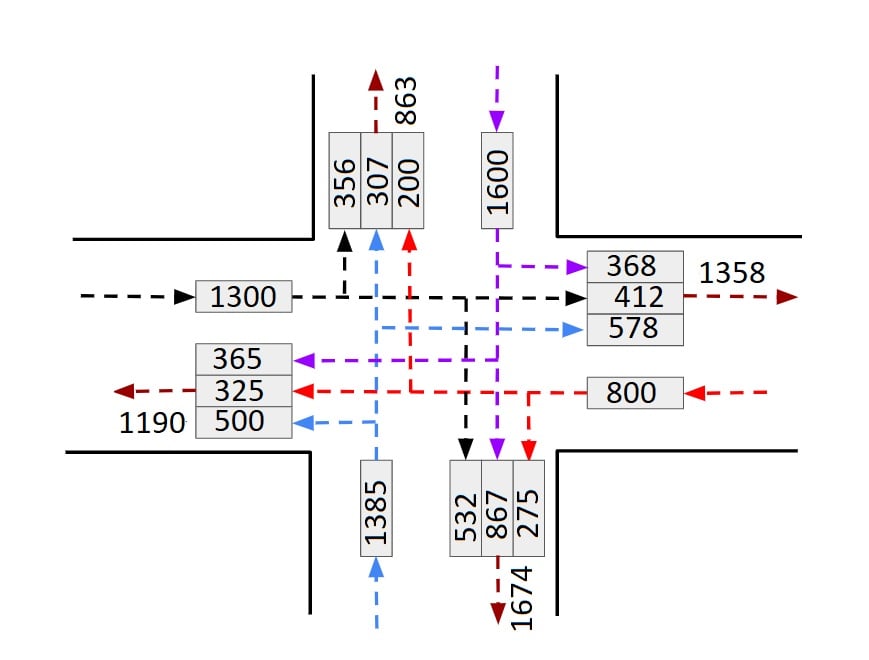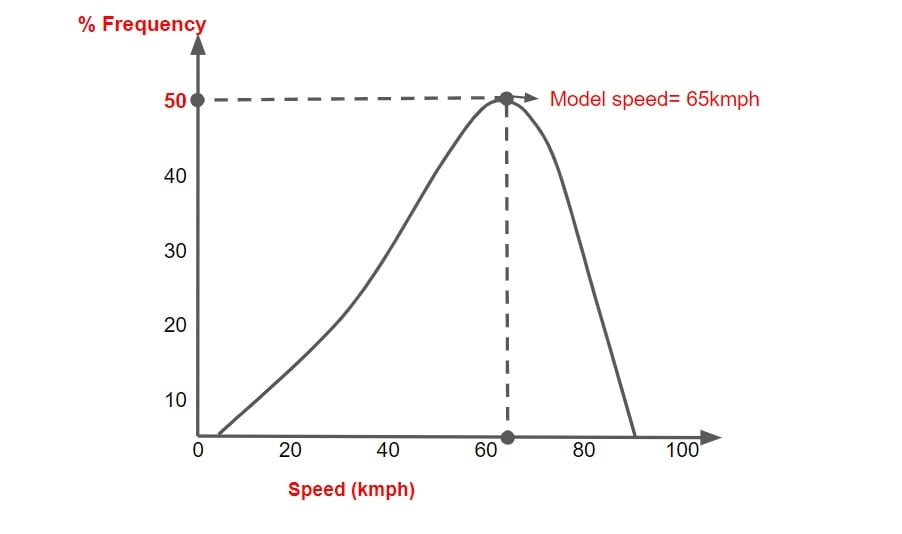Traffic Studies and Analysis
Traffic studies or surveys are carried out to analyze the traffic characteristics. These studies help in deciding the geometric design feature and traffic control for safe and efficient traffic movements. The traffic surveys for collecting traffic data are also called traffic census.
The various traffic studies generally carried out are:
- Traffic Volume Study
- Traffic Speed Studies
- Traffic Flow Characteristics & Capacity Study
- Origin and Destination (O & D) Study
- Parking Study
- Accident Studies
⇒ Traffic Volume Study
Traffic Volume (q)
Number of vehicle crossing the particular section of road is per unit time is called Traffic Volume. It is expressed in veh/day, veh/hr, veh/min.
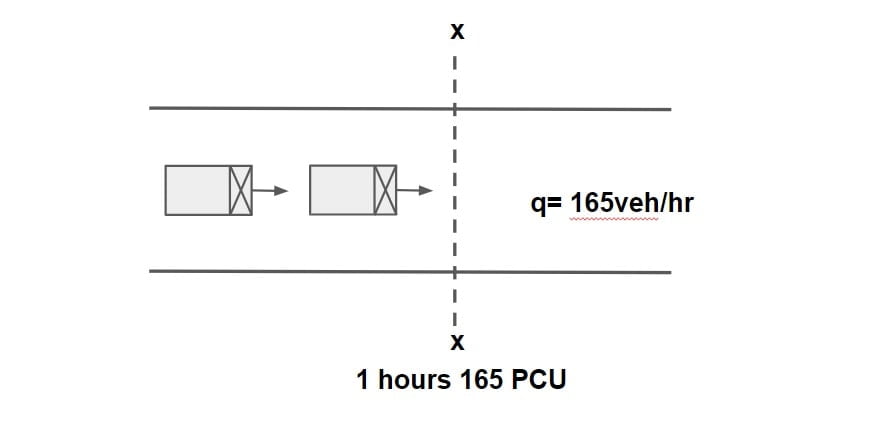
PCU (Passenger Car Unit)
Under mixed traffic condition, It is difficult to find traffic volume, traffic density etc hence all class of vehicle are converted into a standard vehicle unit which is called PCU.
| Class of Vehicle | PCU |
| Car, Tempo | 1 |
| Motar Cycle | 0.5 |
| Cycle Rickshaw | 1.5 |
| Bus, Truck | 3 |
| Horse Drawn Vehicle | 4 |
| Small Bullet Car | 6 |
| Large Bullet Car | 8 |
\(PCU = \frac{\text{Speed Ratio}}{\text{Length Ratio}}\).
\(PCU = \frac{\frac{V_o}{V_i}}{\frac{L_o}{L_i}}\).
Vo and Lo = speed and length of standard vehicle.
Example: The free speed of a car on a 6 lane road is 120kmph, while that of a truck is 60kmph. The length of the car is 5m, where as the length of the truck is 10m. The PCU of the truck is ……
\(PCU =\frac{\frac{80}{40}}{\frac{5}{40}}=4\)Measurements of Traffic Volume
Manual Method
In manual counts trained persons are posted at each lag of an intersection to count and record the number of trucks or buses, cars etc.
Mechanical Method
- Radar (Radio Detection & Ranging)
- CCTV Cameras
- Magnetic Detector
- Pressure Sensitive Detectors
Presentation Of Traffic Volume Data
Traffic Volume Data can be expressed in following different ways.
- Annual Average Daily Traffic (AADT)
- Annual Average Hourly Traffic (AAHT)
- Annual Average Week Day Traffic (AAWT)
- Average Daily Traffic (ADT)
- Trend Chart
- 30th Highest Hourly Volume
- Volume Flow Diagram at Intersection
- Variation Chart
Annual Average Daily Traffic (AADT)
AADT= \(\frac{\text{Total number of vehicles throughout a years}}{365}\) veh/day.
Annual Average Hourly Traffic (AAHT)
AAHT= \(\frac{\text{Total number of vehicles throughout a years}}{365×24}\) veh/hr.
AAHT= \(\frac{AADT}{24}\) veh/hr.
Annual Average Week Day Traffic (AAWT)
AAWT= \(\frac{\text{Total number of vehicles throughout week days}}{260}\) veh/day.
NOTE: AAWT>AADT, as on weekends traffic volume is considerably reduced.
Average Daily Traffic (ADT)
ADT= \(\frac{\text{Total number of vehicles throughout week}}{7}\) veh/day.
NOTE: ADT>AADT
Trend Chart
- Traffic volume data can be represented in form of Trend chart over period of years, which is useful in estimating the rate of growth of traffic that can be used for planning future expansion, design and regulation.
- If from trend chart rate of growth of traffic volume is computed to be r%, then future traffic in given by
A=P(1+r)n
A= future traffic volume
P= present traffic volume
n= no of years.
Note: Average rate of growth of traffic is consider 5-7.5%.
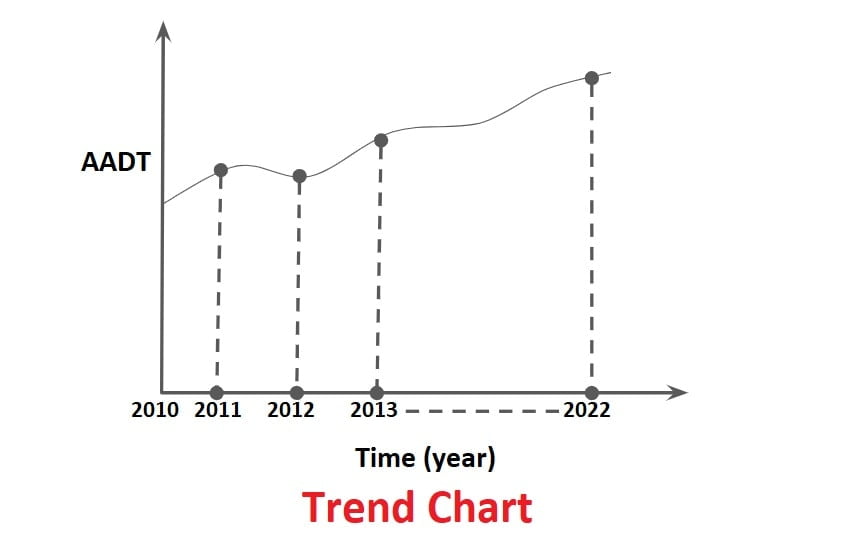
30th Highest Hourly Volume
- It has been observed that 30th highest hourly volume gives a satisfactory results in terms of performance & it is economical in nature.
- 30th highest hourly volume is exceeded only 29 times in a years & all other traffic data will lie lesser than that.
- IRC consider this traffic volume as Design Hourly Volume.
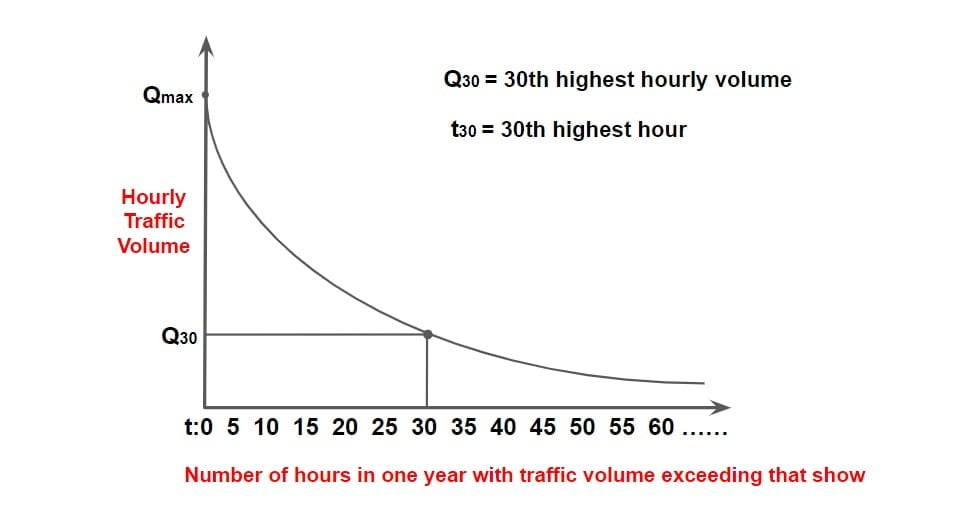
Volume Flow Diagram at Intersection
- Volume flow diagram at intersection either drawn to a certain scale or indicating traffic volume can be used find the details of crossing & turning traffic.
- These data are required for design of Intersection.

Variation Chart
Variation charts shows the hourly, daily and seasonal variations. It helps in deciding the facilities and regulations needed during peak traffic hours.
NOTE:
Periodic Volume Count
⇒In order to find certain traffic data, such as AADT, ADT etc. it is necessary to count traffic for long duration of time(may be for years or months).
⇒Counting traffic for long duration of time, involves cost & effort which is not feasible practically.
⇒Hence to make reasonable estimate of certain traffic data concept of expansion factor can be used in Periodic Volume Count.
⇒In periodic volume count, expansion factors are used as follows.
1.Hourly Expansion Factor (HEF)
HEF= \(\frac{\text{Total traffic for a day}}{\text{Traffic for particular hour}}\)
2.Daily Expansion Factor (DEF)
DEF= \(\frac{\text{Total traffic for a week}}{\text{Traffic for particular day}}\)
3.Monthly Expansion Factor (MEF)
MEF= \(\frac{AADT}{ADT}\)
Peak Hour Factor (PHF)
It is defined as the ratio between the number of vehicles counted during the peak hour and four times the number of vehicles counted during the highest 15 consecutive minutes. Peak hour factor is a measure of the variation in demand during the peak hour.
\(PHF_{15} =\frac{\text{Hourly traffic volume}}{\frac{60}{15}\times V_{15}(max)}\).
\(PHF_{5} =\frac{\text{Hourly traffic volume}}{\frac{60}{5}\times V_{5}(max)}\).
V₁5 = maximum number of vehicle during any 15 consecutive minutes
V5 = maximum number of vehicle during any 5 consecutive minutes.
\(\frac{n}{60}\leq(PHF)_n\leq 1\).
⇒ Traffic Speed Studies
Speed is the rate of travel expressed in kmph or m/s . Over a particular route, the actual speed of vehicle may vary. Speed of vehicle depends upon several factors such as geometric features, traffic conditions, time, place, driver and environment.
Types of Speed
- Spot Speed
- Average Speed
- Time Mean Speed
- Space Mean Speed
- Journey Speed
- Running Speed
Spot Speed
It is an instantaneous speed of vehicle at particular instant of time or section of road. It is measured by: Enoscope, Pressure Contact Tube, Loop Detector.
Average Speed
It is average speed of traffic calculate on the basic of spot speed of so many vehicle. It can be considered in two different ways.
- Time Mean Speed
- Space Mean Speed
Time Mean Speed
Arithmetic mean of spot speed of all vehicle is called Time Mean Speed.
\(V_t= \frac{V_1+V_2….+V_n}{n}\)Space Mean Speed
It is harmonic mean of spot speed of all vehicle.
\(V_s= \frac{n}{\frac{1}{V_1}+\frac{1}{V_2}….+\frac{1}{V_n}}\)Note: Vt>Vs
Journey Speed
Journey Speed =\(\frac{\text{length of journey}}{\text{time of journey}}\)
Running Speed
Running Speed =\(\frac{\text{length of journey}}{\text{Running time}}\)
Running Time = Journey Time – Delay
Generally there are two type of speed studies carried out.
Spot Speed Study
Speed And Delay Study
1.Spot Speed Study
Spot speed studies cannot be used to find density because measurements are done at one point only. Spot speed studies are generally carried out for the following reasons:
- In accident studies
- To calculate the traffic capacity
- Planning of traffic regulations
- Decide the speed trends.
Representation Of Spot Speed Data
Speed Distribution Table
Frequency Distribution Curve
Cumulative Speed of Vehicle
Speed Distribution Table
From the spot speed data of the selected sample, frequency distribution tables are prepared for various speed range and no of vehicle in such range. The arithmetic mean is taken as average speed.
Example
| Speed Rang (kmph) | No of Speed / Frequency Observed | % Frequency |
| 0-10 | 5 | 1.25 |
| 10-20 | 8 | 2 |
| 20-30 | 10 | 2.5 |
| 30-40 | 17 | 4.25 |
| 40-50 | 30 | 7.5 |
| 50-60 | 46 | 11.5 |
| 60-70 | 200 | 50 |
| 70-80 | 52 | 13 |
| 80-90 | 32 | 8 |
| 400 | ||
Frequency Distribution Curve
- Curve plotted between average values of each speed group on the x-axis and the frequency of vehicles in that group on y-axis is known as frequency distribution curve of the spot speed.
- A frequency distribution curve of spot speed is plotted with speed of vehicle or avg. value of each speed group of vehicle on the X- axis and the percentages of vehicle in that group on the Y- axis. This graph is called speed distribution curve.

Model Speed
The speed at which greatest number of vehicle travels. It is the peak value of Frequency Distribution Curve.
Cumulative Speed of Vehicle
A graph is plotted between average value of each speed group on x-axis and cumulative percentage of vehicle travelled at or below different speeds on y-axis.
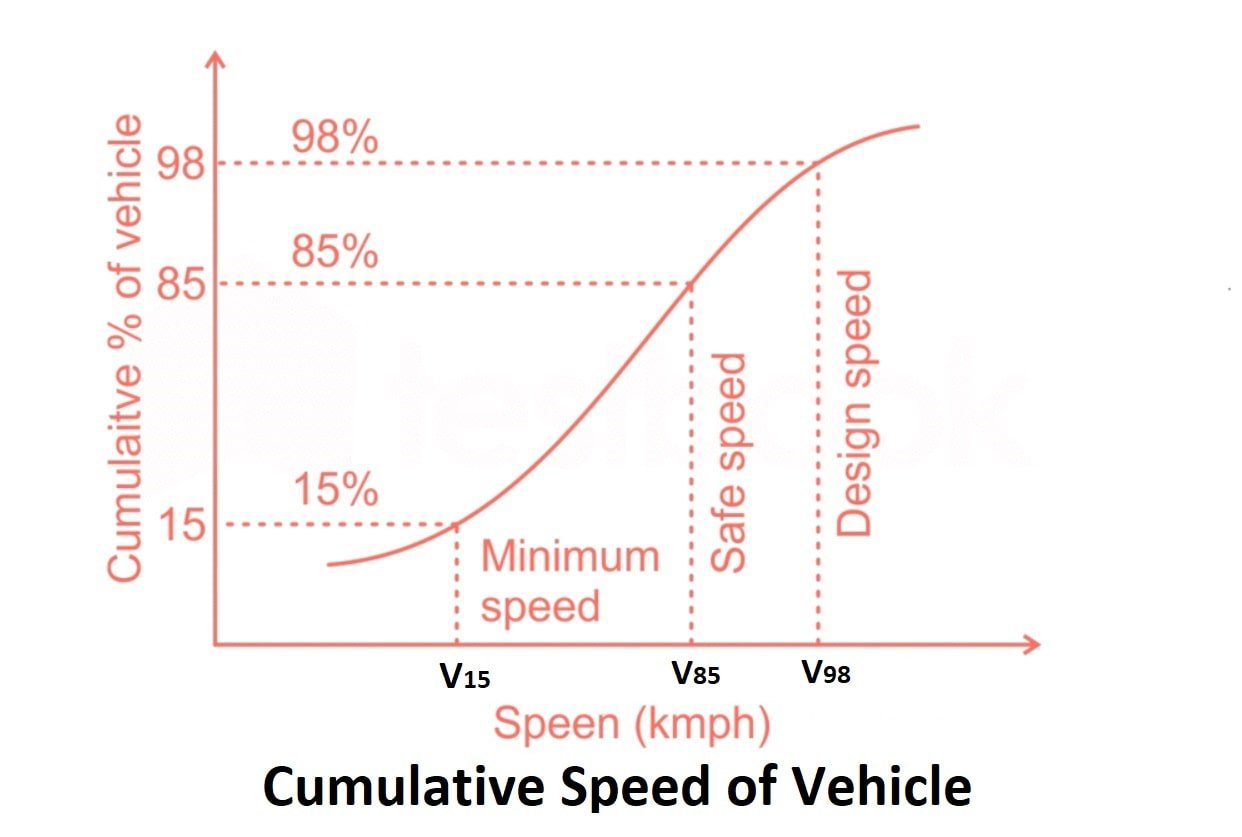
98th percentile speed
It is the speed at or below which 98% of vehicle are moving and only 2% exceeds this limit.
As per IRC this speed is considered as design speed for Geometric design.
85th percentile speed
It is the upper safe movement for vehicle movement.
This is adopted for safe speed limit.
15th Percentile Speed
It is the lower safe limit to avoid congestion.
Minimum speed on Major highway.
50th percentile speed
It is considered as median speed.
2. Speed And Delay Study
We know that spot speed study cannot give the density of traffic. Hence speed & delay studies are carried out over a long distance and hence it is possible to determine density of traffic. This study gives the running speeds, overall speeds, fluctuation in speed and delay between two stations.
There are various methods of carrying out speed and delay study.
- Floating Car Method
- License Plate Method
- Interview Technique
- Elevated Observations
Floating Car Method
- This method is used only for two lane two road. In this method a test vehicle is driven over a given length of road.
- Speed of text vehicle should be approximately same as speed of traffic.
- A group of four observers sitting in test vehicle records various details.
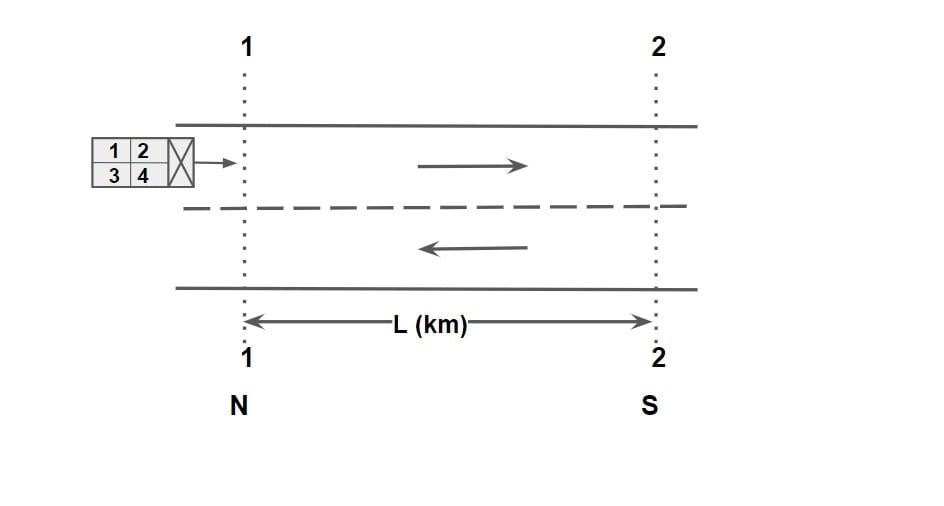 Observer 1: 1st observer will be record total journey time and total cumulative delay time using 2 stop watches.
Observer 1: 1st observer will be record total journey time and total cumulative delay time using 2 stop watches.
Observer 2: Location & Reasons for congestion will be noted by 2nd observer.
Observer 3: Number of vehicle overtaking the test vehicles as well as overtaken by test vehicle will be noted by 3rd observer.
Observer 4: 4th observer counts total number of vehicles in opposite direction on adjacent length.
According to this Method
Traffic Flow (q):
\(q=\frac{n_a+n_y}{t_w+t_a}\)
Journey Time of Flow (\(\bar{t} \))
\(\bar{t}=t_w-\frac{n_y}{q}\)
where
tw= Average journey time when the test vehicle is running with the flow.
ta= Average journey time when the test vehicle is running against the flow.
ny= Average no of vehicle overtaking the test vehicle – Average no of vehicle overtaken by the test vehicle.
ny= overtaking – overtaken. {this can be +ve, -ve or even zero}
na= Average no of vehicle counted in the direction of stream when the test vehicle travels in the opposite direction. {na is measured by 4th observer of opposite direction of test vehicle}
Derivation Of Floating Car Method
Step.1 When test vehicle stop & all other vehicles is moving.

Traffic flow \(q=\frac{n_o}{T} \)
where
T= duration of study
no= number of vehicle overtaking the test vehicle
Step.2 When traffic is stop & test vehicle is moving.
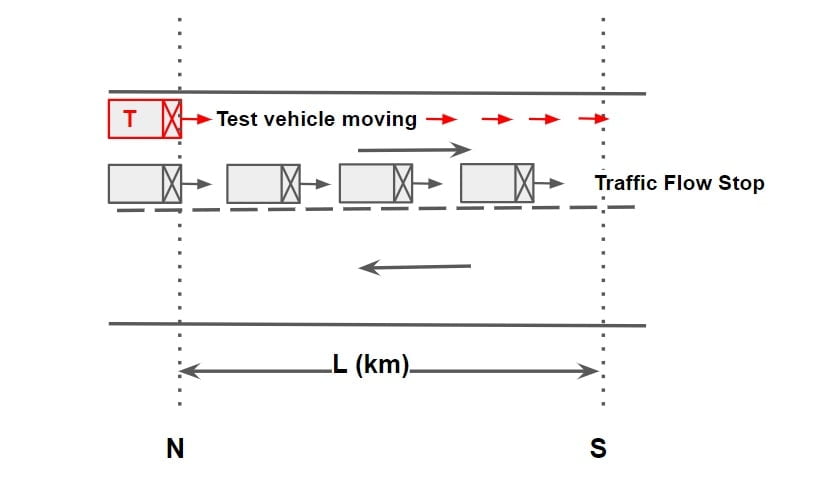
Traffic density \(K=\frac{n_s}{L} \)
ns= KL= KVTT
(∴L=VTT)
ns= KVTT
where
ns= number of vehicle overtaken by test vehicle
Step.3 When test vehicle is moving in the direction of flow & traffic is moving.
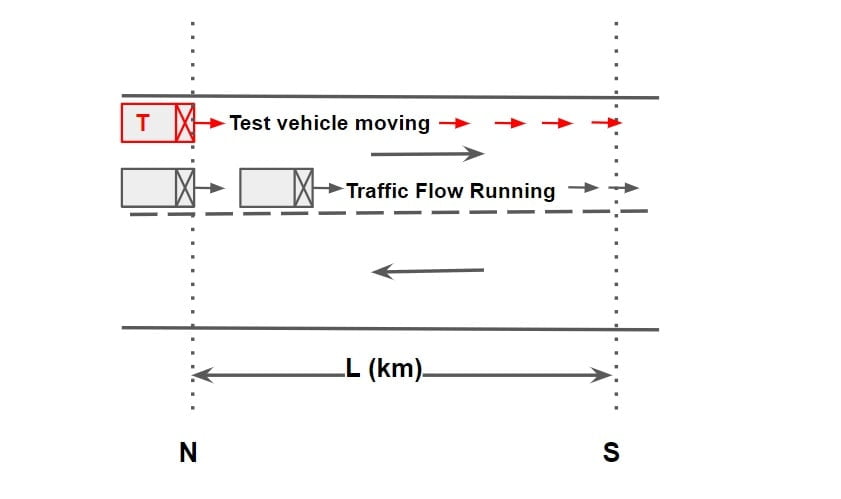
time of journey = tw
ny= Average no of vehicle overtaking the test vehicle – Average no of vehicle overtaken by the test vehicle.
no= number of vehicle overtaking the test vehicle = qtw
ns= number of vehicle overtaken by test vehicle = KL= KVwtw
(overtaking – overtaken)= ny= qtw – KVwtw
ny= qtw – KVwtw
ny= qtw – KL ……….(1)
Step.4 When test vehicle is moving in the opposite direction of flow & traffic is moving.
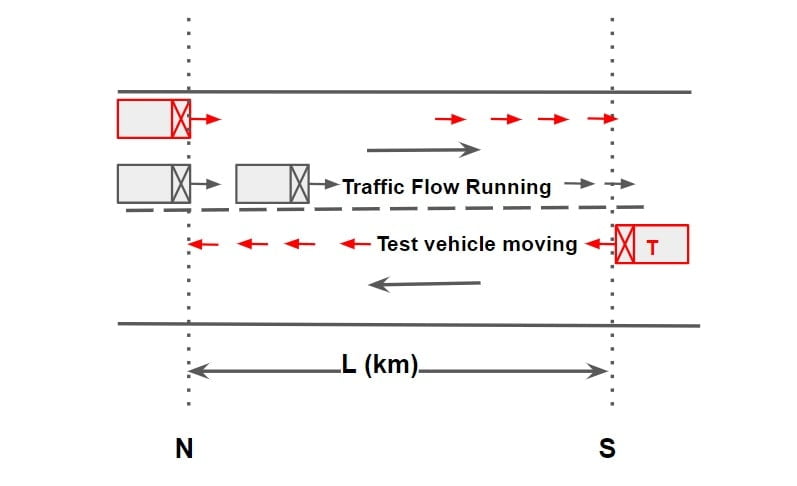 time of journey = ta
time of journey = ta
na= Average no of vehicle counted in the direction of stream when the test vehicle travels in the opposite direction
na= qta + KVata
na= qta + KL ……….(2)
add equation 1 & 2
ny = qtw – KL + na = qta + KL |
| ny+na = qtw + qta |
Traffic Flow (q)
\(q=\frac{n_a+n_y}{t_w+t_a}\)
Journey Time of Flow (\(\bar{t} \))
from equation 1
ny= qtw – KL
K= q/v and L=vt
\(n_y=qt_w-\frac{q}{v}\times v\times t\).
\(n_y=qt_w-q\bar{t}\).
Journey time of flow
\(\bar{t}=t_w-\frac{n_y}{q}\)
